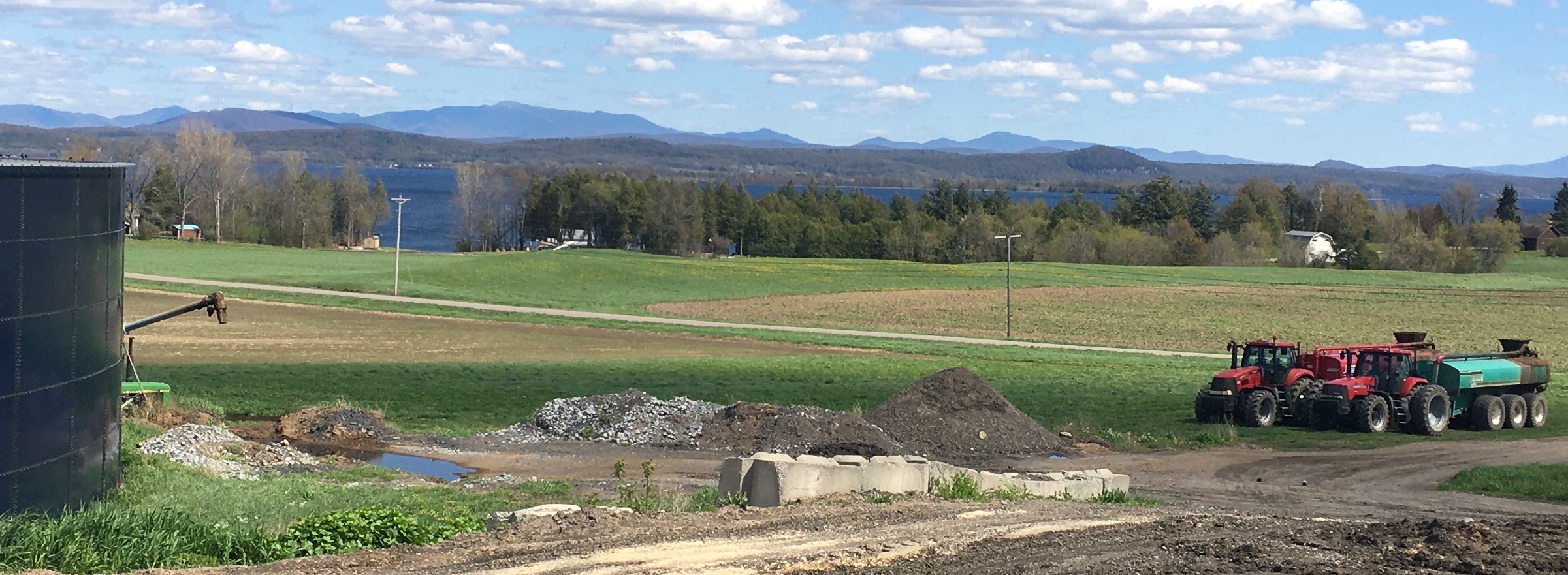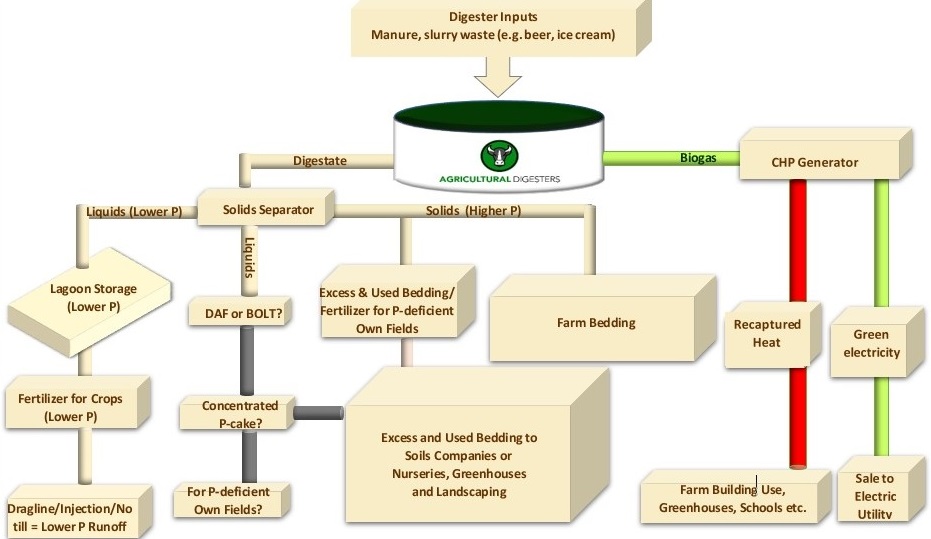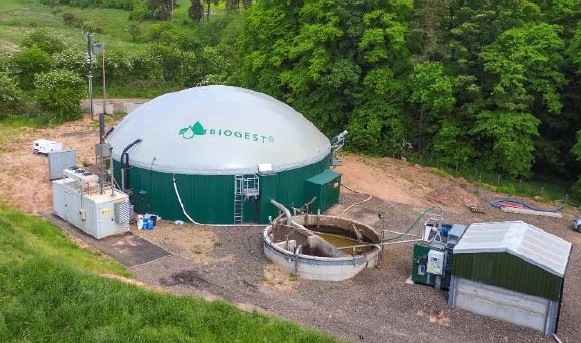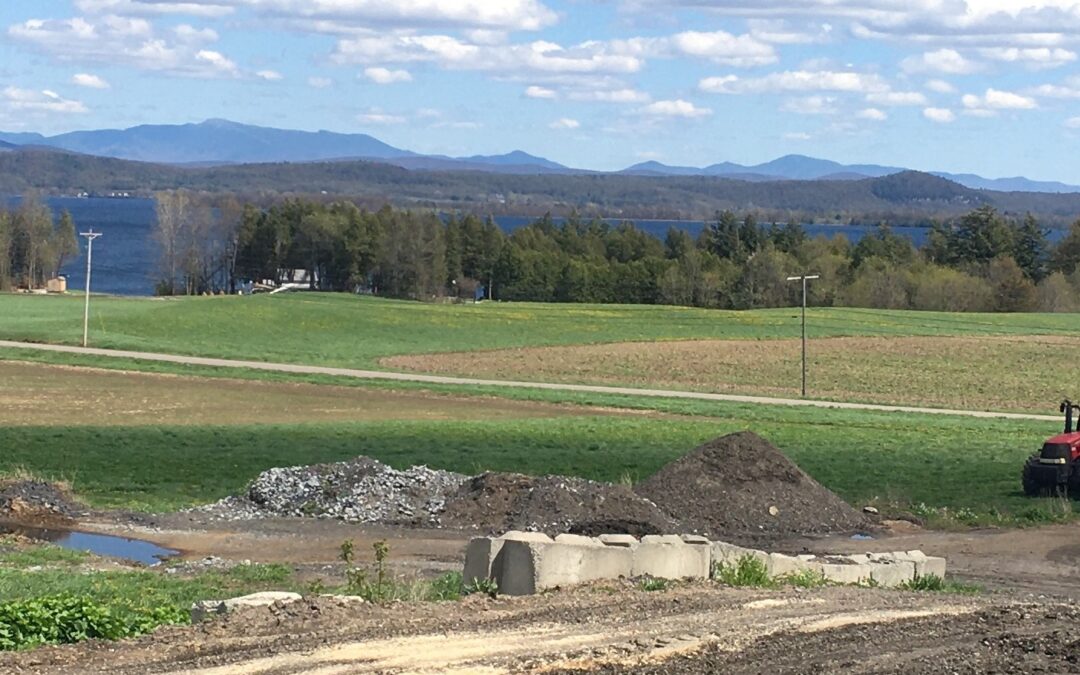
This dairy farm located directly on Lake Champlain will soon have its own Watershed Digester system.
Our new “Watershed Digester” concept interconnects a variety of known practices and technologies for a result greater than the sum of its parts. It is ideally suited for dairy regions with serious water quality problems caused in part by phosphorus runoff from farms.
By quantitatively demonstrating phosphorus reduction by combining a methane digester with other practices, farms are able to access grants and incentives that focus on water quality. In many regions this means the farm’s potential EQIP allocation from NRCS, hundreds of thousands of dollars available each farm bill. Current and future REAP grants as well.
While anaerobic digestion has been far more established in Europe than America, these practices will allow more American dairy farms to use the separated solid fraction as bedding. If used fresh, it has little to no pathogen content and reduces somatic cell-counts and Mastitis rates.
The primary separated liquids from a farm digester have more liquid content and less weight, so they can be spread more easily and absorbed on fields.
They replace the methane-heavy raw manure previously spread on fields and release far less methane from lagoons as well. NRCS and other agricultural specialists are aware of these benefits, but seeing them in effect at more farms will lead additional farms to adopt them.
A major environmental focus in Vermont, New York and Quebec is reducing phosphorus levels in Lake Champlain. Fortunately, when digested manure is separated into liquid and solid fractions, it becomes more manageable. Bedding solids contain phosphorus as well as the liquid fraction. However, the liquid digestate is lighter and has higher “liquidity” so it flows more easily when drag lined and injected in fields.

Our Watershed Digester concept branches out to create farm revenue from electricity, heat, bedding and water quality improvement.
Primary separation of digestate from the anaerobic digester into liquid and solid fractions. The combination of an anaerobic digester, primary separation of the digestate into liquid and solid fractions (in some cases followed by secondary separation of phosphorus from liquid digestate) provides maximum manure management flexibility. In addition, any solids not used as bedding can be sold as compost or peat replacement and transported, along with its phosphorous content, off farm.
The liquid fraction (fertilizer) with less solid content can be absorbed more efficiently into the ground. This is especially true if it is drag lined and injected. In addition, the separated liquids require less pumping and time as well as fossil fuel to power the drag lining equipment. Frontiers | Fertilizing Potential of Separated Biogas Digestates in Annual and Perennial Biomass Production Systems | Sustainable Food Systems (frontiersin.org)
Reducing nutrient pollution. Mineralization and increased plant availability. When separated liquid and manure solids come off a screw press separator, farmers can evaluate their phosphorous content and make more deliberate decisions about how much to spread. With this approach, more of the nutrients actually get used by plants, and less runs off into nearby surface water and groundwater.
During the anaerobic digestion process, nutrients contained in the feedstock are mineralized. Mineralized nutrients are more easily used by a crop. Digested solids contain higher concentrations of plant-available nitrogen and phosphorus compared to as-excreted manure, according to research. Uses of Solids and By-Products of Anaerobic Digestion – Farm Energy (extension.org)
The separated liquid fraction is characterized by high N (mainly in the form of directly plant-available ammonium) and potassium contents and a total solids content of below 5% (Gutser et al., 2005; Möller et al., 2009; Nkoa, 2014). The solid fraction contains approx. 20% of the total N, a third of the total phosphorus and 15% of the potassium and up to 35% total solids (Rolink, 2013; Vaneeckhaute et al., 2017).
The effect of anaerobic digestion on phosphorus (P) forms and water P extractability was investigated using dairy manure samples from six full-scale on-farm anaerobic digesters in Wisconsin, USA. On an average, total dissolved P (TDP) constituted 12 +/- 4% of total P (TP) in the influent to the anaerobic digesters. Only 7 +/- 2% of the effluent was in a dissolved form. Dissolved unreactive P (DUP), comprising polyphosphates and organic P, dominated the dissolved P component in both the influent and effluent. In most cases, it appeared that the fraction of DUP mineralized during anaerobic digestion became subsequently associated with particulate-bound solids. Geochemical equilibrium modeling with Mineql+ indicated that dicalcium phosphate dihydrate, dicalcium phosphate anhydrous, octacalcium phosphate, newberyite, and struvite were the probable solid phases in both the digester influent and effluent samples. The water-extractable P (WEP) fraction in undigested manure ranged from 45% to 70% of TP, which reduced substantially after anaerobic digestion to 25% to 45% of TP. Anaerobic digestion of dairy manure appears capable of reducing the fraction of P that is immediately available by increasing the stability of the solid phases controlling P solubility. https://www.researchgate.net/publication/6516248_Phosphorus_forms_and_extractability_in_dairy_manure_A_case_study_for_Wisconsin_on-farm_anaerobic_digesters https://cleanlakesalliance.org/wp-content/uploads/2016/10/Strategic-Action-Plan-11092012.pdf

In Vermont the Natural Resources Conservation Service (NRCS) seriously considers both greenhouse gas mitigation and water quality improvement.
Phosphorus Reduction with Community Manure Digesters. One of the plan actions specific to Lake Mendota (Wisconsin) calls for building additional community manure digesters. The construction of manure digesters will help to reduce the amount of manure that is applied on lands with high soil phosphorus levels. The farms that contribute to the digesters generally have very high concentrations of animals and produce a significant amount of manure. The digesters process the manure and produce a liquid digestate. According to the Engineering report, the Waunakee digester reduces, by up to sixty percent, the amount of phosphorus in the liquid portion of the manure that is returned to the farms. The digested solids can be sold to companies that make them into other products or export them out of the Yahara River watershed. The liquid digestate can be used to “water” crops—providing moisture and nutrients when the crop most needs them. The benefits of community digesters are numerous. Applying digested manure rather than raw manure to fields will reduce the amount of phosphorus enriched runoff to the lakes. There are enhanced nutrient management requirements that come with being part of the digester cluster; these requirements will help farmers reduce the amount of phosphorus runoff to the lakes. https://madisoncommons.org/archive/index-q=content-despite-manure-spill-supporters-say-community-digesters-have-positive-impact-on-environment.html
Secondary liquid separation. Separating the phosphorus from the liquid digestate has been a desired process for many years. The trick is to produce a product that is marketable for the farmer. A DAF (dissolved air flotation system) is one option. To date however, packaging the moist output has been a challenge.
We recommend another system, the BOLT from GSR Solutions GSR Solutions What We Do (gsrsoln.com) This system, developed with support from NRCS, has been trialed successfully on farms in Vermont and separates phosphorus in a dry, granular form suitable for selling as a highly potent organic fertilizer or soil amendment.
The nutrient management benefit a farm achieves with the primary separation of digested liquids and solids are further increased by secondary separation of the liquids. The farmer can more easily increase or decrease the amount of phosphorus on fields and control the amount of phosphorus runoff into water bodies if required.
Some of our projects will utilize the Bolt system to help provide dairy farmers with a solution to the serious problem of phosphorus runoff.

Our unique, economical digester for mid-size farms (200-700 milking) is the centerpiece for a system mitigating phosphorus runoff.
Storage benefits. Still another benefit is the ability to store liquid digestate in lagoons and spread it at agronomic rates at the time of crop need, (just prior to planting) Utilizing dragline technology, this digestate can be applied efficiently, with little impact on the farm operation by operators. These practices help prevent the release of nitrous oxide, another potent greenhouse gas which occurs when fertilizer is not managed efficiently.
Drag lining, injection, no-till and partial no till. Digestate with high liquidity is also more effective with no-till farming and cover crops “achieved carbon neutral farming by using liquid digestate, cover crops and minimal tillage” Liquid digestate and min-till help farm get to carbon neutral – Farmers Weekly (fwi.co.uk)
There is awareness of these practices and more farmers follow them every year. Drag lining liquid digestate is easier and less costly than raw manure (less time and fossil fuel needed). In addition, the liquid digestate is absorbed by the soil more easily, especially when injected. It is more plant available and has less water-soluble phosphorus. In those areas where phosphorus runoff into lakes is a major problem (e.g., VT, NY, CT and WI) it provides a major water quality benefit. No-till practices on our farms will prevent run-off, allow for the use of cover crops, build soil tilth and improve soil organic matter.
An increase in digester deployment on farms should increase the use of these practices.
Partial composting and full composting. Digested solids are an excellent bedding source; in addition, the digester produces significantly more solid bedding than required by the cows. This excess is an excellent, spongy, holding material the color of dirt and can be sold directly to compost companies by the farm. We have offers to buy this material from various companies. Here is video of a presentation made by Agricultural Digesters LLC and Agricycle Energy at a recent Vermont Organics and recycling Summit. Vermont Organics Recycling SummitAgricultural Digesters
A method that requires less transportation (time and fossil fuels) while providing the farm significant income, would be to “compost” materials fully at the farm and have end users pick them up there. This approach has already been successful using raw manure. An open house in Fairfield, Vermont on May 20, 2022 Maximizing Digested Solids Via Full Composting | Agricultural Digesters demonstrated different products that can be offered including some with the addition of woodchips to make more of a mulch. Both the farmer and ADLLC feel the granular phosphorus from the GSR Solutions “Bolt” could also be a valued additive. It can be shown that compost made from digested solids, rather than raw manure is more effective and ADLLC expects to launch a digester at this farm in late 2023. The processing of this material on a concreted slab, and distribution to customers, also reduces runoff on the farm.
We seek to establish a community of farm digesters that will diversify to the point they sell not only milk and meat but also electricity, bedding offsets, heat offsets and organic compost sales. Along with this, environmental payments for reducing phosphorus runoff.

